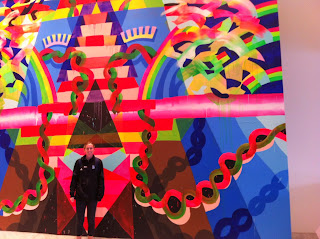Event #4:
For my fourth event I was fortunate enough to be able to
attend Dr. Eric Vilain, who is a doctor and professor here at UCLA, speak about
Forrest Bess’s artwork at the Hammer Museum (Forrest Bess- “Seeing things
Invisible”). When I took my seat in the gallery, I was ready to hear Dr. Eric
Vilain’s thoughts and understandings of the artwork that was hanging on the
walls around me. The main topic that was emphasized throughout his talk was
“Intersex”. Dr. Vilain emphasized the meaning behind intersex and how children
at the young age develop in either direction (male or female). What occurs in
the child is the external and internal genitalia are “undifferentiated”, which
means that the child can develop either a testicle or ovaries.
 |
| Dr. Eric Vilain |
As Dr. Vilain continued with his presentation, he began
referring to Forrest Bess’s artwork and how it portrays symbolic
representations of both male and female genitalia. An important piece of his
talk that I thought was very interesting was the fact that Forrest Bess uses
different colors throughout his paintings to show the distinction between male
and females. The color red represents masculinity as the color white represents
femininity. Forrest Bess’s pieces of art were his way of expressing his own
inner conflict and how he was dealing with coming to terms with his
identity/physical conditions. Dr. Vilain expressed that throughout his artwork,
Forrest Bess was able to come to terms with his own sexuality.
This event was very different however it provided great
information on how artists tend to use their artwork as a way to express their
personal and inner struggles. Forrest Bess’s artwork incorporated not only
intricate designs to appeal to the viewer but it also displayed and attempted
to show the viewer “invisible things”. This is in fact the title of his gallery
and with Dr. Vilain’s presentation, I was able to get a better grasp on what in
fact Bess was trying to express through his artwork. Forrest Bess used his
artwork as a way to incorporate the human body and illustrate both the male and
female genitalia.
Sources: (No pictures were allowed in the gallery)
Image #1: Dr. Eric Vilain. http://socgen.ucla.edu/people/eric-vilain/






















